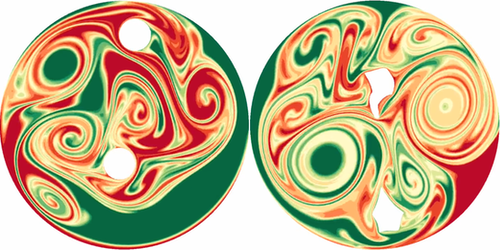Effectively Mixing Two Fluids
Understanding how fluids mix is important for applications ranging from the blending of foods and cosmetics to the tracking of plastic debris in Earth’s oceans. Using a supercomputer, Peter Schmid of the King Abdullah University of Science and Technology, Saudi Arabia, and Maximillian Eggl of the Johannes Gutenberg University Mainz, Germany, have now found a selection of stirrer shapes and stirring velocities to more effectively mix two fluids [1]. Videos of their simulations illustrate the way changes in both factors can drastically alter how homogeneous the system looks after mixing.
In their simulations, Schmid and Eggl poured two liquids into a cylindrical container. They then placed into the container two circular stirrers, which they moved for a fixed time at the same constant velocity in a circular, clockwise path around the cylinder. This “control” simulation shows a partially mixed system with large regions where the original fluids remain unmixed.
The duo then adjusted the stirrers’ shapes to optimize the mixing of the fluids. They found better mixing—a more homogeneous system once stirring halted—when the stirrers had irregular shapes. The top stirrer resembled a fairy’s star-shaped wand, while the other looked like a pooper-scooper. These stirrers induced in the system more vortices, which improved mixing.
Once Schmid and Eggl had finalized the shapes of their stirrers, they then adjusted the velocity at which the stirrers moved. They found that the best mixing happened if the top stirrer traveled faster than the bottom one, with both moving clockwise initially and then the bottom one taking a small, counterclockwise jump at the end.
Finally, the duo had the computer simultaneously adjust stirrer shape and velocity. Doing that, they found that the best stirrers had smoother edges and less extreme shapes. The star-shaped wand was rounded into a canine-tooth-like shape, while the pooper-scooper was transformed into a stubby tadpole. For the stirrer motion, the two stirrers no longer moved in the same direction. Rather, the top stirrer moved counterclockwise and the bottom clockwise, with the two appearing to pinch the interface between the two fluids. At the end of the simulations, the stirrers jiggled back and forth, an action that created more vortices, making mixing more efficient.
While Schmid and Eggl recognize that most industries wouldn’t implement such irregular stirrer shapes or stirring methods, they hope that their findings might shift how people think about the mixing of fluids.
–Allison Gasparini
Allison Gasparini is a freelance science writer based in Santa Cruz, CA.
References
- M. F. Eggl and P. J. Schmid, “Mixing by stirring: Optimizing shapes and strategies,” Phys. Rev. Fluids 7, 073904 (2022).




